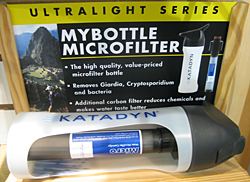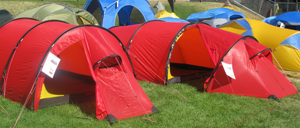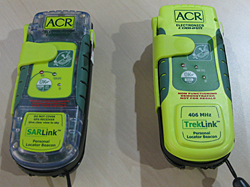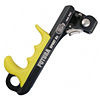Bill S offers his point of view on Day Two (July 22) of Outdoor Retailer.
(Publication of this blog was delayed a day due to poor internet access at OR.)
I apologize for my blog installments being a bit late. However, the Wi-Fi at the Salt Palace is having problems (Alicia gets a connection at her lodging, so is a few days faster).
The day started with the Conservation Alliance breakfast and a superb presentation by Rick Ridgeway. He showed fantastic photos of places that progress has been made in preserving literally millions of acres and a thousand river miles due to efforts by small grassroots groups funded in part by the Conservation Alliance. The Alliance funds are provided by contributions of the outdoor manufacturers, dealers, and guide services, among others. Trailspace is a supporter of the Conservation Alliance.
One of Rick’s stories was of the tracking of a wolverine, designated M-3, from his radio collar. The range travelled by M-3 was amazingly large, covering several thousand square miles in the US and Canada. A big effort is being made by the Conservation Alliance to search out and designate corridors and range of a number of important species through the grants program.
Katadyn
 At Katadyn, I looked at the latest version of their MyBottle, a system in which the filter is incorporated into the bottle itself. You fill the bottle with the water to be made potable, preferably pre-filtered through something like a coffee filter, to remove the larger chunks (coffee filters have a pore size of 5 microns, according to the technical people at the booth). The pleated filters in both the microfilter and purifier versions of the bottle are 0.3 microns.
At Katadyn, I looked at the latest version of their MyBottle, a system in which the filter is incorporated into the bottle itself. You fill the bottle with the water to be made potable, preferably pre-filtered through something like a coffee filter, to remove the larger chunks (coffee filters have a pore size of 5 microns, according to the technical people at the booth). The pleated filters in both the microfilter and purifier versions of the bottle are 0.3 microns.
The difference between the two is that the microfilter has only the pleated filter, which is attached to the cap, and through which the water is drawn as through a straw, while the purifier has a filtration chain like the older version of the bottle. That is, the first stage of the in-line filter is a fine filter to remove much of the turbidity, along with activated carbon to remove chemical tastes and some contaminant chemicals. Because of the wide variety of chemical contaminants in various water sources, plus the lack of a standard, there is no rating for removal of contaminants (so be careful of water from streams in former or current mining areas or with heavy agricultural runoff).
The second stage is the pleated filter, which again removes protozoa (giardia, crypto, and their cysts), bacteria, and some viruses. The third stage is an iodine resin, to deal with viruses. The pump filters have not been changed technically. We had a further discussion of water issues in general. The technical people were aware of my 4-part article here on Trailspace and considered it to cover the issues at the level it was aimed for reasonably well.
Hilleberg

Other Hilleberg tents on display at Tent City.
I took a swing by one of my favorite tentmakers, Hilleberg. Their newest tent is a multi-person tent, the Altai, shaped much like a yurt. If you pitch it on snow, you can dig out below, much as with a tarp tent, to form table and benches. You can also sleep at least 6 people in a tent that weighs 4 pounds 2 ounces in the ultralight version. Add 3.5 pounds if you use the regular poles, or on a backcountry ski tour, just use your adjustable ski poles - pretty light for a tent in which a 6.5 foot tall person can stand and can sleep 6 (more if the group is friendly). Like all Hilleberg tents, this one will stand up to the winds of the Scandinavian winter.
Bo Hilleberg and his family test out all their tent designs personally in a wide variety of conditions before putting them on the market. Unfortunately for those of us living in California and a few other states, the fire codes for tents do not allow Hilleberg tents to be sold in our local stores. From what I can tell, though, other tents that are sold in my state are no more fire-safe. You should never cook in the vast majority of tents or have any flame in them.
ACR
 At ACR, I looked at their two new Personal Locator Beacons (PLB). These are to be on market in a few months. The TrekLink ($399) is a small 406 MHz beacon that uses the COSPAR-SARSAT system to relay an emergency signal via the satellites to the appropriate agency in the country to which the beacon is registered. It does not have a GPS receiver, but is located by the satellite triangulation method (that is an oversimplified name for a moderately complex process). It can take about 20 minutes to get a reasonable location.
At ACR, I looked at their two new Personal Locator Beacons (PLB). These are to be on market in a few months. The TrekLink ($399) is a small 406 MHz beacon that uses the COSPAR-SARSAT system to relay an emergency signal via the satellites to the appropriate agency in the country to which the beacon is registered. It does not have a GPS receiver, but is located by the satellite triangulation method (that is an oversimplified name for a moderately complex process). It can take about 20 minutes to get a reasonable location.
The SARLink includes a 66 channel GPS receiver, and thus can get the appropriate agency alerted in less than 3 minutes. In addition, when the SARLink is activated, an LED strobe flashes at regular intervals to aid searchers. At 70F, the battery life is 40 hours of transmission time. As you would expect, the time is shorter at low temperatures, being about 36 hours at -4F. There are test modes for both devices, though there is a limit to how many tests can be run before affecting battery life. This type of PLB must be registered in the country of usage, with updating of the information (such as party size and emergency contacts) desirable for each trip. The best practice, of course, is to not depend on rescue, but to plan and proceed in a safe manner.
Kong
 At the climbing end of the Salt Palace, I found a couple of interesting new pieces of hardware, both from Kong. First was the Kong Duck Ascender. This is similar to the Ropeman, but adds the capability of working on slings as well as rope.
At the climbing end of the Salt Palace, I found a couple of interesting new pieces of hardware, both from Kong. First was the Kong Duck Ascender. This is similar to the Ropeman, but adds the capability of working on slings as well as rope.
 The other was an extremely lightweight ascender, the Kong Futura Rope Handle. It looks much like a traditional ascender with the outer part of the handle cut off. Instead of moving the ascender up and hanging onto the outer frame of the ascender, you wrap your hand around the Futura to grip the fingerslots (the rope itself lies inside a deep groove in the ascender). This would cut the weight carried for ascenders to 250 grams for a pair (less than a half pound).
The other was an extremely lightweight ascender, the Kong Futura Rope Handle. It looks much like a traditional ascender with the outer part of the handle cut off. Instead of moving the ascender up and hanging onto the outer frame of the ascender, you wrap your hand around the Futura to grip the fingerslots (the rope itself lies inside a deep groove in the ascender). This would cut the weight carried for ascenders to 250 grams for a pair (less than a half pound).

 by Bill Straka
by Bill Straka









